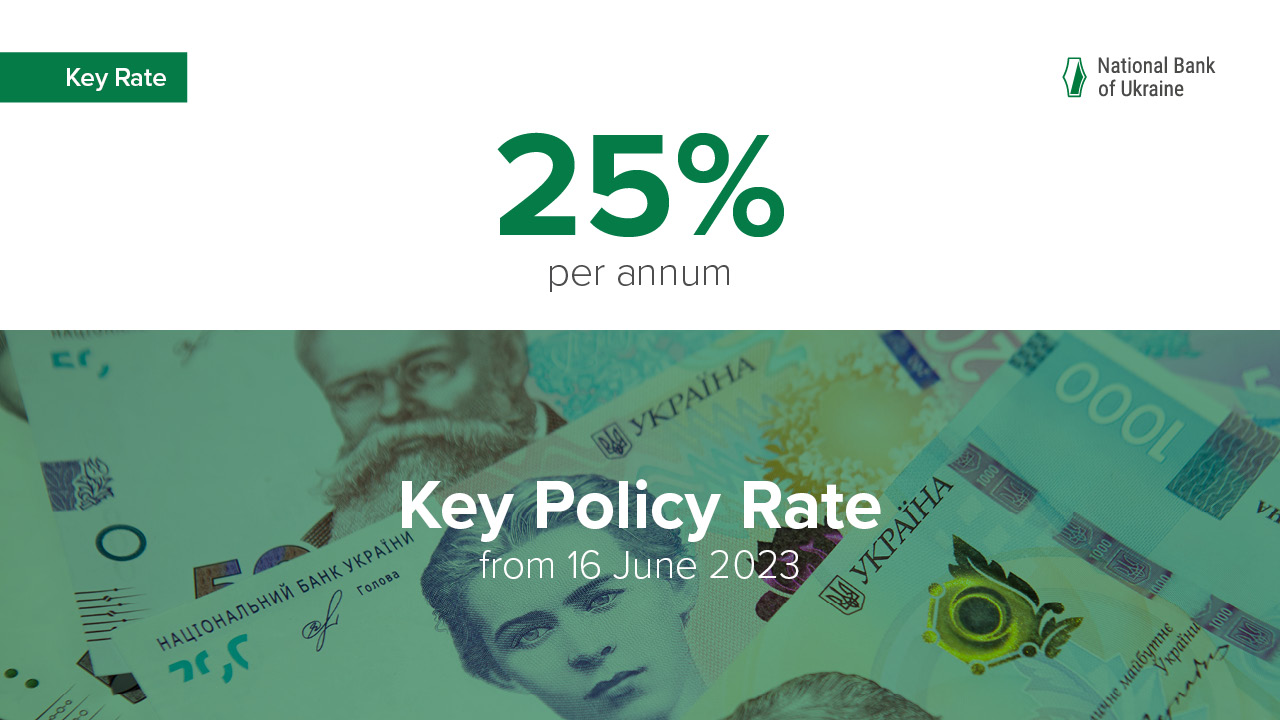The Board of the National Bank of Ukraine has decided to keep its key policy rate at 25% per annum. This will help maintain the attractiveness of hryvnia-denominated instruments, preserve the sustainability of the FX market, and reduce inflation. Combined, these results will pave the way for the further gradual easing of FX restrictions.
Inflation continues to decrease rapidly, including due to the NBU’s measures
The pace of consumer price growth continued to decline faster than expected. Inflation eased to 15.3% yoy in May. Apart from the base effect, the pullback in inflation was driven by an ample supply of food and fuel, a stronger hryvnia cash exchange rate, and improved exchange-rate and inflation expectations. Among other things, the NBU’s efforts to keep the key policy rate high and make hryvnia instruments more attractive made it possible to stabilize the FX market and improve expectations.
Although headline inflation has decelerated, underlying inflationary pressures remain rather high. Specifically, core inflation declined to only 15.6% yoy in May, which matches the NBU’s forecast. Such dynamics indicate, among other things, that businesses’ war-related expenses continued to pass through to the prices of goods and services.
The NBU expects that the easing of inflation will continue, though at a more moderate pace
Thanks to the removal of supply chain disruptions, the reduction of prices in the global commodity markets, and the consistent monetary policy of the NBU, inflation in Ukraine will continue to decelerate. However, this process will not be as rapid as in previous months. First, the base effect, which contributed to a significant drop in inflation in H1 2023, will gradually fade. Second, price dynamics will be affected by increases in certain utility tariffs and the announced return of pre-war taxes on fuels.
In addition, the blowing up of the Kakhovka HPP by russian invaders will have an adverse impact on prices. By the NBU’s early estimates, this act of terror will contribute about 0.3 pp to this year’s inflation rate because of how it has complicated the operation of multiple enterprises, and due to the partial loss of crops, primarily vegetables, that it has led to.
The war is taking an increasingly large toll, but steady inflows of international aid and the revival of the domestic debt market have made it possible to cover the significant budget deficit without resorting to monetary financing
Since the beginning of the year, international partners have granted Ukraine about USD 20 billion in assistance. In addition, the NBU’s and the government’s joint efforts have increased the amount of funds that goes into the state budget from the sale of domestic government debt securities. All of this made it possible to successfully finance the significant deficit of the state budget in January–May. Given the sustainability of international support and the gradual revival of the economy, Ukraine will be able to continue to cover all necessary expenditures without going back to monetary financing.
The key risk to inflation dynamics and economic development is the longer duration, and the unpredictable nature and intensity, of the full-scale war
Although Ukraine is gradually liberating its territories, high uncertainty persists over when the active phase of hostilities will end. russian invaders continue to perpetrate targeted terrorist attacks, which have led to the loss of civilian lives and caused environmental disasters. The long-term effects of the destruction of the Kakhovka HPP are unprecedented in magnitude. It will take time to fully assess them. The barbaric nature of russia's war and the prolongation of hostilities continue to threaten Ukraine with significant losses of economic potential and with unpredictable inflationary shocks.
Other risks also persist. They include:
- the continued destruction of critical infrastructure facilities, including energy infrastructure, by the aggressor country, which may lead to the resumption of significant power shortages and restrictions on economic activity and exports, and consequently to higher pressure on the FX market
- the emergence of additional budget needs and substantial quasi-fiscal deficits, including in the energy sector and
- disruptions or a shutdown of the “grain corridor” and the ongoing limitations imposed on imports of Ukrainian food by some European countries.
Conversely, the rapid implementation of Ukraine’s recovery project, together with European integration reforms, could considerably accelerate the pace of economic growth and reduce inflation at a faster rate.
In order to maintain exchange rate sustainability, with a view to ensuring a steady decline in inflation and creating the right conditions for a gradual easing in FX restrictions, it is important that hryvnia instruments remain highly attractive. In view of that, the NBU Board decided to keep the key policy rate at 25% per annum
The key policy rate continues to play an important supporting role in ensuring the sustainability of the FX market and protecting international reserves. Maintaining the key policy rate at a high level, together with other NBU measures, was instrumental in substantially increasing the attractiveness of hryvnia instruments. Real yields on hryvnia instruments continue to rise, driven by ongoing interest rate hikes by the banks and by steadily declining inflation and improving expectations.
This has bolstered households’ interest in hryvnia deposits and domestic government debt securities in recent months. Time hryvnia deposits also returned to growth. Coupled with other factors, this helped boost the resilience of the FX market, laying the foundations for a continued easing in FX restrictions.
In particular, the NBU allowed residents to transfer money abroad, with a view to repaying certain foreign loans. What is more, the central bank is currently working on additional measures to ease FX restrictions.
Maintaining the key policy rate at its current level will shore up positive effects from previously introduced measures, thus helping reduce FX market risks further.
The NBU will continue to deliver the monetary conditions required for maintaining exchange rate sustainability and ensuring a steady drop in inflation
The NBU is ready to start a monetary easing cycle earlier than it envisaged in its April macroeconomic forecast, if the growth in real yields on hryvnia instruments and the reduction of risks to exchange rate sustainability continue to occur faster than expected.
This could be facilitated by a faster decline in consumer and core inflation and a more rapid increase in international reserves than envisaged in the forecast, as well as by the greater effectiveness of the measures taken to make hryvnia instruments attractive. Obstacles to a faster transition to a monetary easing cycle could arise from new challenges for exchange rate sustainability and a steady drop in inflation resulting from the russian invasion.
The decision to keep the key policy rate at 25% from 16 June 2023 was approved by NBU Board Decision on the key policy rate No.215, dated 15 June 2023.
A summary of the discussion by Monetary Policy Committee members that preceded the approval of this decision will be published on 26 June 2023.
The next monetary policy meeting of the NBU Board will be held on 27 July 2023, according to the confirmed and published schedule.


